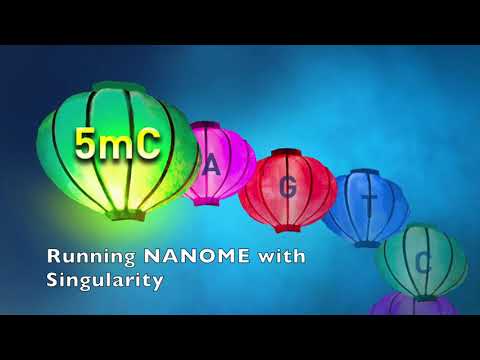NANOME (Nanopore methylation) pipeline developed by Li Lab at The Jackson Laboratory
Project description
DNA methylation-calling tools for Oxford Nanopore sequencing: a survey and human epigenome-wide evaluation
--NANOME(Nanopore methylation) pipeline of DNA methylation calling tools for Oxford Nanopore sequencing
Methodology of NANOME pipeline
Background: Nanopore long-read sequencing technology greatly expands the capacity of long-range, single-molecule DNA-modification detection. A growing number of analytical tools have been developed to detect DNA methylation from nanopore sequencing reads. Here, we assess the performance of different methylation calling tools to provide a systematic evaluation to guide researchers performing human epigenome-wide studies.
Fig. 1A. Survey of methylation calling tools . Timeline of publication and technological developments of Oxford Nanopore Technologies (ONT) methylation calling tools to detect DNA cytosine modifications.

Results: We compared several analytic tools for detecting DNA modifications from nanopore long-read sequencing data. We evaluated the CpG methylation-detection accuracy, CpG site coverage, and running time using nanopore sequencing data across different genomic contexts, using natural human DNA. Furthermore, we provide an online DNA methylation database (https://nanome.jax.org) with which to display the DNA methylation levels detected by nanopore sequencing and bisulfite sequencing data across different genomic contexts.
Conclusions: Our study is the first benchmark of state-of-the-art methods for detection of mammalian whole-genome DNA-modifications in nanopore sequencing. We provide a broad foundation for cross-platform standardization, and an evaluation of analytical tools designed for genome-scale modified-base detection using nanopore sequencing.
Highlights of NANOME pipeline
Several first highlights for NANOME
- Enables users to process terabasescale Oxford Nanopore sequencing datasets.
- Provide a one command line, end-to-end pipeline for analyzing Nanopore sequencing data for all methylation-calling tools.
- Support various platform executions: local, HPC and CloudOS, without needs for tools' installation (NANOME support docker and singularity).
- First standardized whole genome-wide evaluation framework, considering per-read and per-site performance for singletons/non-singletons, genic and intergenic regions, CpG islands/shores/shelves, different CG densities regions and repetitive regions.
- The first Nextflow based DNA methylation-calling pipeline. Please check more articles about Nextflow based workflow technology from Nature Biotechnology: https://doi.org/10.1038/s41587-020-0439-x and https://doi.org/10.1038/nbt.3820.
CI/CD features
We use CI Automation Tools to enable the automated testing on every commit and on PRs to make sure that updates are not introducing bugs. Please check the automatic testing results on Github.
System Requirements
Hardware requirements
NANOME pipeline can be easily configured with different RAM, CPU/GPU resources schema to parallelly run methylation-calling tools. For optimal usage, we recommend running NANOME pipeline on HPC or cloud computing platform, e.g., google cloud platform (GCP). The basic hardware requirements are below:
- GPU or CPU with 2+ cores.
- RAM: 7+ GB per cpu.
- Storage using HDD or SSD. Please ensure your storage before running the pipeline.
Software requirements
NANOME pipeline uses Nextflow technology. Users only need to install Nextflow (check the installation guide from https://nf-co.re/usage/installation), and have one of below commonly used environment tool:
- conda
- docker
- singularity
We provide conda, docker and singularity environments that depend on below well-known open-source packages for methylation calling on nanopore sequencing data:
nanopolish >=0.13.2
megalodon >=2.2.9
deepsignal >=0.1.8
ont-tombo >=1.5.1
deepmod >=0.1.3
METEORE >=1.0.0
ont-pyguppy-client-lib >=4.2.2
fast5mod >=1.0.5
Guppy software >= 4.2.2 from ONT (Oxford Nanopore Technologies) website
Installation
Users only need to install Nextflow (https://nf-co.re/usage/installation). NANOME execution environment will be automatically configured with the support of conda, docker or singularity containers. Below is steps for installing Nextflow:
# Add channel and install nextflow
conda config --add channels defaults
conda config --add channels bioconda
conda config --add channels conda-forge
conda install nextflow
conda update nextflow
nextflow -v
NANOME pipeline support running with various ways in different platforms:
- Docker
- Singularity
- Conda
- Local execution: running directly on default platform
- HPC clusters with SLURM support
- Google Cloud Platform (GCP) with google-lifesciences support
Simple usage
We provide a tutorial video for running NANOME pipeline:
When you have Nextflow software, NANOME pipeline can be directly executed without any other additional installation steps:
# Run NANOME via docker
nextflow run TheJacksonLaboratory/nanome\
-profile test,docker
# Run NANOME via singularity
nextflow run TheJacksonLaboratory/nanome\
-profile test,singularity
Please note that above two commands are integrated in our CI/CD test cases. Our Github will automatically test and report results on every commit and PRs (https://github.com/TheJacksonLaboratory/nanome/actions). Please refer to Usage for how to use NANOME pipeline. For running on CloudOS platform (e.g., google cloud), please check Usage on CloudOS.
We firstly proposed the standardized whole genome-wide evaluation packages, check standardized evaluation tool usage for more detail. We do not suggest evaluating on a portion of CpGs for performance comparisons.
Pipeline reports for NANOME
Benchmarking reports on our HPC using Nextflow
We constructed a set of benchmarking datasets that contain reads from 800 to about 7,200 reads for NA19240, and monitored job running timeline and resource usage on our HPC, reports generated by Nextflow workflows are: Trace file, Report and Timeline.
Our HPC hardware specifications are as follows:
- CPU: Intel(R) Xeon(R) Gold 6136 CPU @ 3.00GHz
- GPU: Tesla V100-SXM2-32GB
- RAM: 300 GB
- Slurm manager version: 19.05.5
Timeline figure for benchmarking experiments are below:
Pipeline DAG
NANOME report
Please check NANOME report for the sample report by NANOME pipeline.
Revision History
For release history, please visit here. For details, please go here.
Contact
If you have any questions/issues/bugs, please post them on GitHub. We will continuously update the Github to support famous methylation-calling tools for Oxford Nanopore sequencing.
Reference
Detailed results can be found in our publication. Please cite our article below if you are interested in our GitHub repository:
DNA methylation-calling tools for Oxford Nanopore sequencing: a survey and human epigenome-wide evaluation. Genome Biology 22, 295 (2021). https://doi.org/10.1186/s13059-021-02510-z
https://genomebiology.biomedcentral.com/articles/10.1186/s13059-021-02510-z
Project details
Release history Release notifications | RSS feed
Download files
Download the file for your platform. If you're not sure which to choose, learn more about installing packages.
Source Distribution
Built Distribution
Hashes for nanome_jax-1.3.14-py3-none-any.whl
| Algorithm | Hash digest | |
|---|---|---|
| SHA256 | 14bb7d1486dff8e3dc31099e93ead22546df63fbc12bfeefc74ac8583f3e4345 |
|
| MD5 | 1689644e6fd9757103fcff96149a7ac4 |
|
| BLAKE2b-256 | a8c0bc61748e41b7c91f98a043e8f98fdad052408f4abef8636a268d6229d0ec |
















